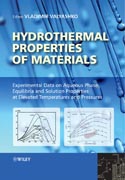
Hydrothermal properties of materials: experimental data on aqueous phase equilibria and solution properties at elevated temperatures and pressures
Valyashko, Vladimir
Discussing experimental methods, equipments, and accuracy measurements, Hydrothermal Experimental Data: Phase Equilibria and Solution Properties in Binary and Ternary Systems Above 200 C provides detailed information on the importantaspects of the physicochemical properties of hydrothermal systems. Featuring a comprehensive data collection of over 1,000 entries, the text?s original experimental data is gathered in an appendix to each chapter and placed on a CD, making this fully loaded resource a must-have for chemists, materials scientists, geologists, and all engineers involved in fuel cell development and the power industry. INDICE: Chapter 1: Phase Equilibria in Binary and Ternary Hydrothermal Systems (V.M.Valyashko). 1. Introduction. 2. Experimental methods for studying hydrothermal phase equilbria. 2.1. Methods of visual observation. 2.2. Methods of sampling. 2.3 Methods of quenching. 2.4 Inderect methods. 3. Phase equilibria in binary systems. 3.1. Main types of fluid phase behavior. 3.2. Classification of complete phase diagrams . 3.3. Graphical representation and experimental examples of binary phase diagrams. 4. Phase equilibria in ternary systems. 4.1. Graphical representation of ternary phase diagrams. 4.2. Derivation and classification of ternary phase diagrams. Chapter 2: pVTx Properties of hydrothermal systems (Horacio R. Corti and Ilmutdin M. Abdulagatov). 1. Basic principles and definitions. 2. Experimental methods. 2.1 Constant volume piezometers (CVP). 2.2 Variable volume piezometers (VVP). 2.3 Hydrostatic weighing technique (HWT). 2.4 Vibrating tube densimeter (VTD). 2.5 Synthetic fluid inclusion technique . 3. Theoretical treatment of pVTx data. 3.1 Excess volume. 3.2 Modelsfor the standard partial molar volume . 4. pVTx data for hydrothermal systems. 4.1 Laboratory activities . 4.2 Summary Table. 5. References. Chapter 3: High temperature potentiometry (Donald A. Palmer and Serguei N. Lvov). Introduction. Experimental methods. Data treatment. Acknowledgments. References. Chapter4: Electrical Conductivity in Hydrothermal Binary and Ternary Systems (Horacio R.Corti). Introduction. Basic principles and definitions. Experimental methods. Static high temperature and pressure conductivity cells. Flow-through conductivity cell. Measurement procedure. Data treatment. Dissociated electrolytes. Associated electrolytes. Getting information from electrical conductivity data. General trends. Specific conductivity as a function of temperature, concentration and density. The limiting molar conductivity. Concentration dependenceof the molar conductivity and association constants. Molar conductivity as a function of temperature and density. Conductivity in ternary systems. References. Chapter 5: Thermal Conductivity (Ilmutdin M. Abdulagatov and Marc J. Assael). 5.1. Introduction. 5.2. Experimental Techniques. 5.3. Available Experimental Data. 5.4. Discussion of Experimental Data. References. Figure Captions. Chapter 6: Viscosity (Ilmutdin M. Abdulagatov and Marc J. Assael). 6.1.Introduction. 6.2.Experimental Techniques. 6.3. Available Experimental Data. 6.4. Discussion of Experimental Data. References. Figure Captions.
- ISBN: 978-0-470-09465-5
- Editorial: John Wiley & Sons
- Encuadernacion: Cartoné
- Páginas: 304
- Fecha Publicación: 21/11/2008
- Nº Volúmenes: 1
- Idioma: Inglés
